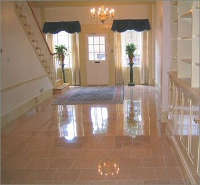
Granite Slabs & Tiles
Polished Finish(See other page for honed & flamed finishes)
How to:
Seal | Clean | Repair | Protect
Strip & Restore | Easy Care
Phone Viewing Tips:
Turning it sideways can improve viewing
Page bounce? Reload it. Different browsers can handle pages differently.
Turning it sideways can improve viewingPage bounce? Reload it. Different browsers can handle pages differently.



More granite details:
Although polished granite will bead water, there may be sufficient (invisible to the naked eye) "micro crack" separations between granite particles to allow the entrance of a highly penetrating staining liquid allowed to stand for a length of time. Once past the polished finish, these liquids are in contact with the absorbent natural stone. Phenol based cough syrup, some fruit juices, etc. have managed to do this. To deal with this type of stain situation, click here.
When you compare polished marble and limestone to polished granite, it is often difficult to tell which is which. You cannot tell by look or feel. As granite does not react with acidic liquids, cleaners are not a concern unless they can create a stain. Sealing options are below. Here is how you can do an acid test to confirm which you have. Be sure to test on the underside as acid will etch marble and limestone faces.
As you progress down this page you will see:
- The products you may need for surface Preparation before sealing.
- Pictures of each of the recommended sealers for this surface type. Click the sealer's picture for it's full description.
- Handy tips to prevent issues that others have had before coming to Aldon.
- Perhaps more information than you need now, but might be of interest later.
Your Choices for Sealing
This surface can be difficult to achieve a nice looking sealer appearance because it is very low absorption with a shiny, tight, polished finish. Water base penetrating sealers have a difficult time penetrating down. Solvent base penetrating sealers may require being sprayed to achieve a smooth finish.
Our suggestions to test are:- Penetrating petroleum solvent formulas with acrylic solids. These can be sprayed to finish nicely, but solids level might need to be adjusted if manufacturer allows dilution.
- Water based film forming that can flow out and self-level.
- Water based penetrating that is usually invisible when dry.
- Click here to see What effects you can expect from each sealer type.
- Click here to see our suggested sealers, cleaners, and application tools.
Some questions you may not be thinking to ask right now that could become important:
. Was it sealed in the past? Does that matter?
. Will a new sealer be compatible with whatever was used before?
. What sealer will give the visual results you want?
. Will you also be able to have a sealer solve problem(s)? ( Answer: yes. Just know which to pick.)
Items of Interest
How to select a sealer
A sealer can do far more than just bead water and look pretty! To see what that is click here.
Important: If your project has had any sealer applied in the past, it must be evaluated differently. To see why, Click here!
Sealer "solids" levels?
A porous surface will require more gallons (more money) of a lower solids sealer than using a higher solids level sealer. That, plus different surfaces have different requirements. It is only a matter of which is best for your needs.
The more porous the surface, the more solids will be required to achieve the desired effects of gloss, strengthening, stopping efflorescence, etc.
The more porous the surface, generally the greater the need for the sealer to create a stronger surface.
An old sealer below the surface, even after stripping, will lower the absorption and porosity to some degree. Sometimes it is uneven below the surface and can create an uneven coloring effect with a color enhancing sealer applied later. Another reason to test first.
Do not believe yet that you have the type of surfacing you were told:
Colors fading?
Renew a glossy finish
Re: "penetrating sealers": do not apply thin layer upon thin layer. Apply a sufficient quantity to insure below surface penetration & bonding. A layer of sealer on top of another layer of sealer can result in poor bonding between layers and that can cause separation peeling that looks grayish.
Concerned about Doing It Yourself or what your contractor says?
If you are concerned about doing it yourself - consider that the satisfaction of a project is directly related to YOUR knowledge of what needs to be done and how. Who actually does the work is less important.
The goal for contractors is - NO CALL BACKS. A good contractor will understand the logic of not taking shortcuts.
©
The goal for contractors is - NO CALL BACKS. A good contractor will understand the logic of not taking shortcuts.
